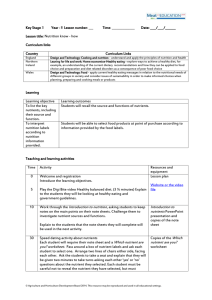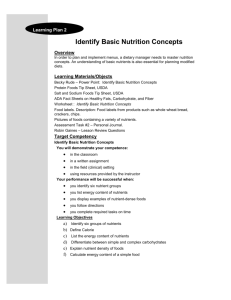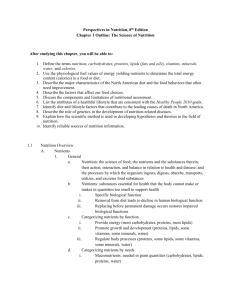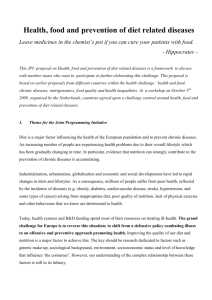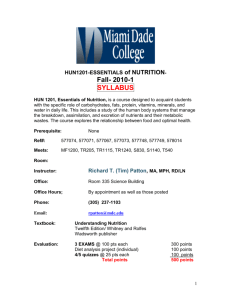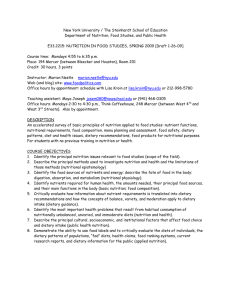Nutrition 101-Week 1
advertisement
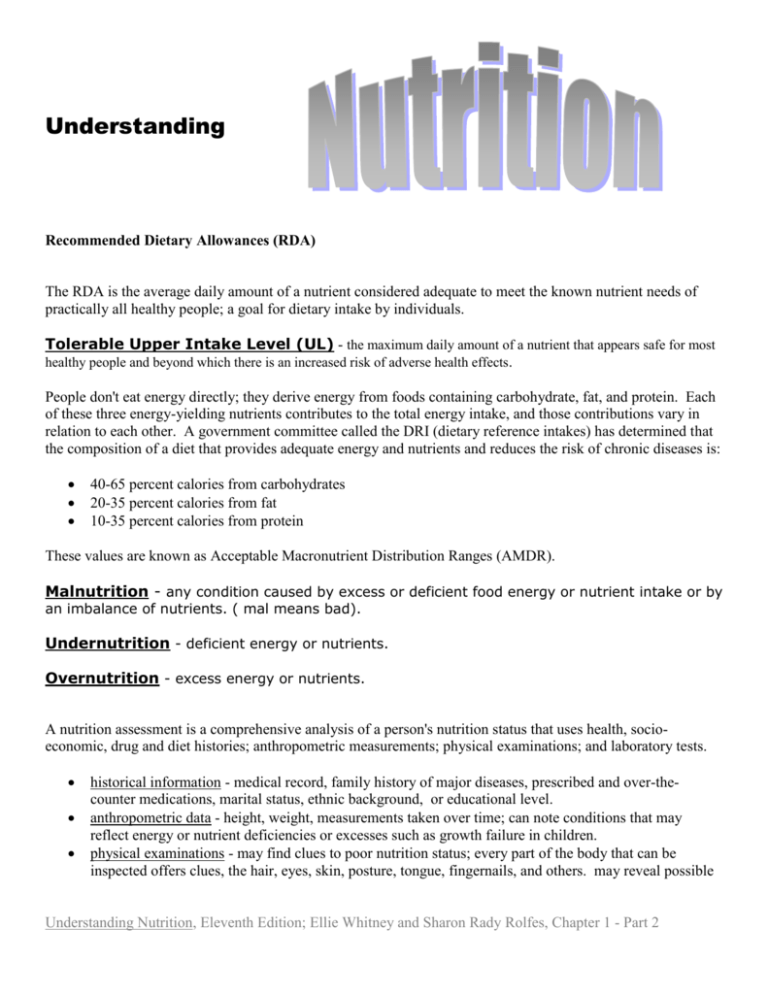
Understanding Recommended Dietary Allowances (RDA) The RDA is the average daily amount of a nutrient considered adequate to meet the known nutrient needs of practically all healthy people; a goal for dietary intake by individuals. Tolerable Upper Intake Level (UL) - the maximum daily amount of a nutrient that appears safe for most healthy people and beyond which there is an increased risk of adverse health effects. People don't eat energy directly; they derive energy from foods containing carbohydrate, fat, and protein. Each of these three energy-yielding nutrients contributes to the total energy intake, and those contributions vary in relation to each other. A government committee called the DRI (dietary reference intakes) has determined that the composition of a diet that provides adequate energy and nutrients and reduces the risk of chronic diseases is: 40-65 percent calories from carbohydrates 20-35 percent calories from fat 10-35 percent calories from protein These values are known as Acceptable Macronutrient Distribution Ranges (AMDR). Malnutrition - any condition caused by excess or deficient food energy or nutrient intake or by an imbalance of nutrients. ( mal means bad). Undernutrition - deficient energy or nutrients. Overnutrition - excess energy or nutrients. A nutrition assessment is a comprehensive analysis of a person's nutrition status that uses health, socioeconomic, drug and diet histories; anthropometric measurements; physical examinations; and laboratory tests. historical information - medical record, family history of major diseases, prescribed and over-thecounter medications, marital status, ethnic background, or educational level. anthropometric data - height, weight, measurements taken over time; can note conditions that may reflect energy or nutrient deficiencies or excesses such as growth failure in children. physical examinations - may find clues to poor nutrition status; every part of the body that can be inspected offers clues, the hair, eyes, skin, posture, tongue, fingernails, and others. may reveal possible Understanding Nutrition, Eleventh Edition; Ellie Whitney and Sharon Rady Rolfes, Chapter 1 - Part 2 imbalances that must be confirmed by other assessment techniques, or can confirm results from other assessment measures. laboratory tests - samples of blood or urine with the results compared to a similar population sample; confirm suspicions of other assessments American eating habits have changed over the last fifty years. We eat out more often, drink more sweetened beverages, eat more snacks, eat moe high energy, nutrient poor dense foods, CHRONIC DISEASES Statistical studies have shown that certain conditions and behaviors are linked to certain diseases. Most chronic diseases arise from multiple factors over many years. A person who died of heart disease may have been overweight, had high blood pressure, been a cigarette smoker, and spent years eating a diet high in saturated fat and getting too little exercise. Not all people who die of heart disease fit this description, no do all people with these characteristics die of heart disease. People who are overweight might die from the complication s of diabetes instead, or those who smoke might die of cancer. They might even die from something totally unrelated to any of these factors, such as an automobile accident. As knowledge about these next diseases and diets increased, the death rates of heart disease, cancer, stroke, and accidents decreased. Death rates for diabetes -- a chronic disease closely associated with obesity -- increased. Leading Causes of Death in the US Heart disease Cancers Strokes Chronic lung diseases Accidents Diabetes mellitus Pneumonia and influenza Alzheimer's disease Kidney diseases Blood infections % of Total Deaths 28% 22.7% 6.4% 5.2% 4.5% 3% 2.7% 2.6% 1.7% 1.4% Diseases that are highlighted have relationships with diet. The bolded disease has a relationship with alcohol. Chronic disease - diseases characterized by a slow progression and long duration. Examples include heart disease, cancer, and diabetes. Risk Factor - a condition or behavior associated with an elevated frequency of a disease but not proved to be causal. Leading risk factors for chronic diseases include obesity, cigarette smoking, high blood pressure, high blood cholesterol, physical inactivity, and a diet high in saturated fats and low in vegetables, fruits, and whole grains. The most prominent factor contributing to death in the United States is tobacco use, followed closely by diet and activity patterns, and then alcohol use. Risk factors such as smoking, poor dietary habits, physical inactivity, and alcohol consumption are personal behaviors that can be changed. Decisions to not smoke, to eat Understanding Nutrition, Eleventh Edition; Ellie Whitney and Sharon Rady Rolfes, Chapter 1 - Part 2 a well-balanced diet, to engage in regular physical activity, and to drink alcohol in moderation (if at all) improve the likelihood that a person will enjoy good health. Other risk factors, such as genetics, gender, and age, also play important roles in the development of chronic diseases, but they cannot be changed. Cigarette smoking is responsible for almost one of every five deaths each year. Risk Factors Tobacco Poor diet/inactivity Alcohol Microbial agents Toxic agents Motor vehicles Firearms Sexual behavior Illicit drugs % of Deaths Caused by 18% 15% 4% 3% 2% 2% 1% 1% 1% Your food choices play a key role in keeping you healthy and reducing your risk of chronic diseases. Identify the factors that most influence your food choices for meals and snacks. List the chronic disease risk factors and conditions that you or members of your family have. Describe lifestyle changes you can make to improve your chances of enjoying good health. Understanding Nutrition, Eleventh Edition; Ellie Whitney and Sharon Rady Rolfes, Chapter 1 - Part 2



